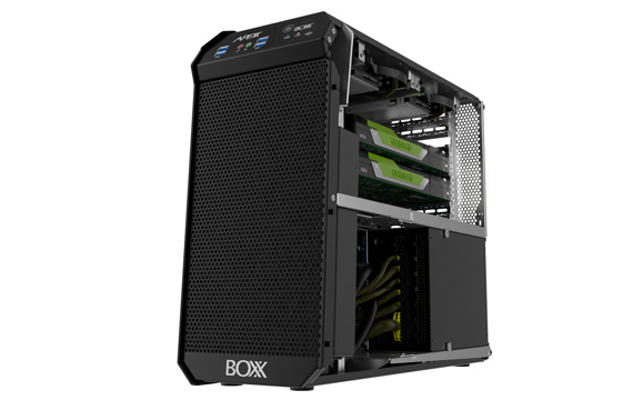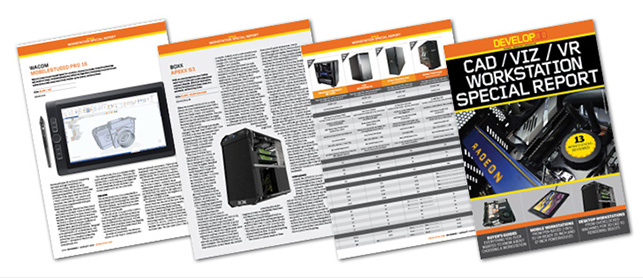APEXX S3 – With an overclocked six core ‘Coffee Lake’ Core i7 CPU and a well engineered compact chassis, this is an impressive CAD workstation but it does come at a premium
When we started DEVELOP3D in 2008, almost all CAD workstations came with a quad core CPU. If you wanted more cores, say to cut render times, you needed a specialist CPU and deeper pockets. You also had to accept that performance in single threaded applications like CAD would fall, due to a drop in GHz.

Ten years later and things have finally changed. The new Intel ‘Coffee Lake’ Core i7-8700K is the first mainstream Intel processor to feature six cores. And despite having 50% more than its predecessor, the ‘Kaby Lake’ Core i7-7700K, it should also deliver a small performance improvement in CAD.
The Core i7-8700K has a base frequency of 3.7GHz, at which all six cores can run, but is designed to Turbo up to 4.7GHz in lightly threaded workflows. This is a much wider frequency range than the ‘Kaby Lake quad core i7-7700K (4.2GHz – 4.5GHz) but becomes irrelevant in the APEXX S3, the latest workstation from custom system builder BOXX.
BOXX has overclocked the Core i7-8700K so all six HyperThreaded cores run at 4.8GHz, all of the time. This makes a big difference in CPU rendering applications.
The APEXX S3 completed our Luxion KeyShot render test 38% faster than the overclocked 4.6GHz Core i7- 7700K Scan 3XS workstation we reviewed in March).
Previously, in order to get this level of rendering performance, you had to go for a specialist overclocked Intel CPU with 8 cores or more, which was significantly more expensive and has a lower clock speed.
This is a welcome boost to CAD users who rely on rendering as an key part of their workflow. The emphasis on CAD is important here, as this where the APEXX S3 excels. Indeed, it set a new record in our SolidWorks IGES export test, which uses a single CPU core to process the parts in a complex CAD assembly.
Our test machine was kitted out with 32GB DDR4-2666MHz memory, which should be a match for very complex CAD models. But if you frequently use multiple applications as part of your product development workflow, then it can go up to 64GB, distributed across 8 DIMMs.
In order to push the Core i7-8700K beyond its stock clock speed, BOXX has used an enterprise-class closed loop water cooling solution which connects via a flexible pipe to a large radiator at the front of the machine, cooled by two fans. With air drawn in at the front and expelled at the rear of the machine this does mean some of the heat extracted from the CPU is pushed back into the chassis. However, while fan noise was noticeable, we found it to be perfectly acceptable throughout all of our testing — although the RPM of the fans cycled up and down every 10 seconds or so during our KeyShot renders which some might find annoying (this didn’t happen in V-Ray or SolidWorks PhotoView 360 where it was consistent).
APEXX S3 – product specifications
■ Intel Core i7-8700K (overclocked to 4.8GHz) (6 cores, 8 Threads)
■ 32GB (2 x 16GB) DDR4 2,666MHz
■ Nvidia Quadro P2000 (5GB) (376.84 driver) or Nvidia Quadro P4000 (8GB) (376.84 driver)
■ 512GB Samsung 960 Pro M.2 NVMe SSD
■ ASRock Z370 Taichi
■ 174 x 388 x 452mm / N/A
■ Microsoft Windows 10 Pro
■ 2 year return to base (other options up to 5 years on-site)
CPU benchmarks (single threaded) – Seconds (smaller is better)
SolidWorks 2015 IGES export: 83
CPU benchmarks (multi-threaded) – Seconds (smaller is better)
Luxion KeyShot 6.1 render test: 363
V-Ray CPU rendering benchmark (CPU): 79
GPU compute benchmark – Seconds (smaller is better)
V-Ray render benchmark (GPU): 177 (Quadro P2000) 106 (Quadro P4000
3D graphics benchmarks (3D CAD) – Score (bigger is better)
SPECapc for SolidWorks 2015 (shaded + edges): 7.25 (Quadro P2000) 7.55 (Quadro P4000)
SPECapc for SolidWorks 2015 (RealView + shadows): 12.60 (Quadro P2000) 13.43 (Quadro P4000)
SPECapc for SolidWorks (RealView + shadows + AO): 28.64 (Quadro P2000) 35.18 (Quadro P4000)
SPECapc for PTC Creo 3.0 (shaded + edges): 11.75 (Quadro P2000) 11.93 (Quadro P4000
SPECapc for PTC Creo 3.0 (reflection): 15.98 (Quadro P2000) 17.13 (Quadro P4000
3D graphics benchmarks (design viz) – Frames Per Second (FPS) (bigger is better)
LumenRT (hotel model) (FPS): 36 (Quadro P2000) 50 (Quadro P4000)
LumenRT (roundabout model): 13.5 (Quadro P2000) 21 (Quadro P4000)
Autodesk LIVE (Villa Enhanced model): 92 (Quadro P2000) 146 (Quadro P4000
Autodesk VRED Professional (AA off):33 (Quadro P2000) 53 (Quadro P4000)
Autodesk VRED Professional (AA medium): 18 (Quadro P2000) 29 (Quadro P4000)
Autodesk VRED Professional (AA ultra high ): 18 (Quadro P2000) 29 (Quadro P4000)
3D graphics benchmarks (VR) – Frames Per Second (FPS) (bigger is better)
VR Mark (Orange): 115.77 (Quadro P2000) 184.88 (Quadro P4000)
VR Mark (Blue): 19.71 (Quadro P2000) 33.17 (Quadro P4000)
VR Mark (Cyan): 62.22 (Quadro P2000) 100.12 (Quadro P4000







